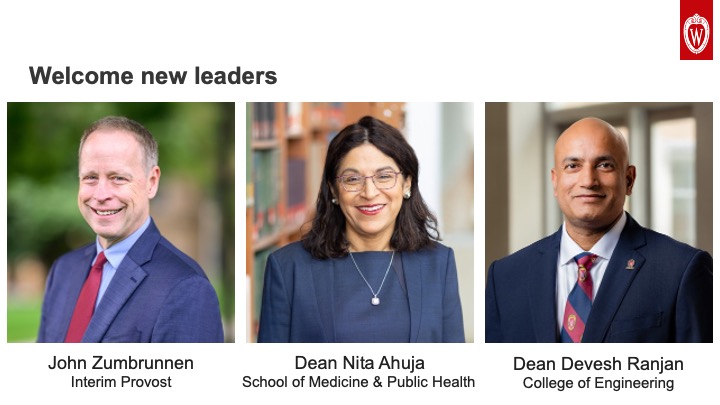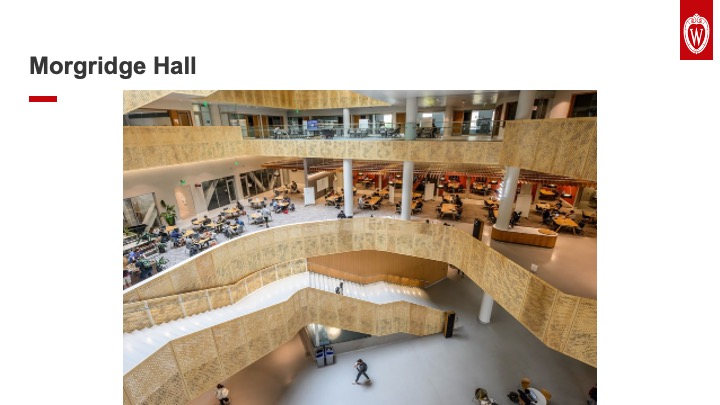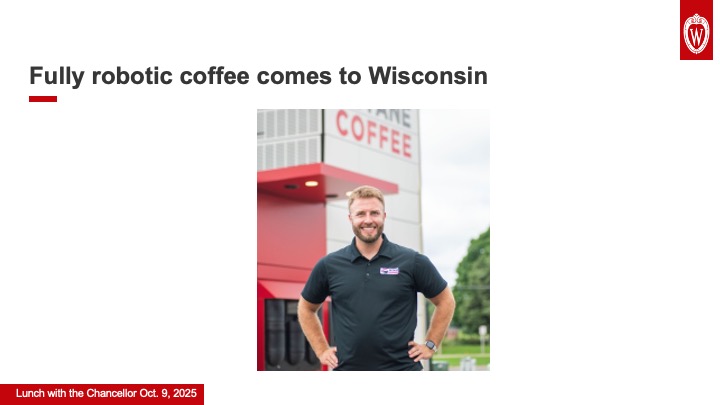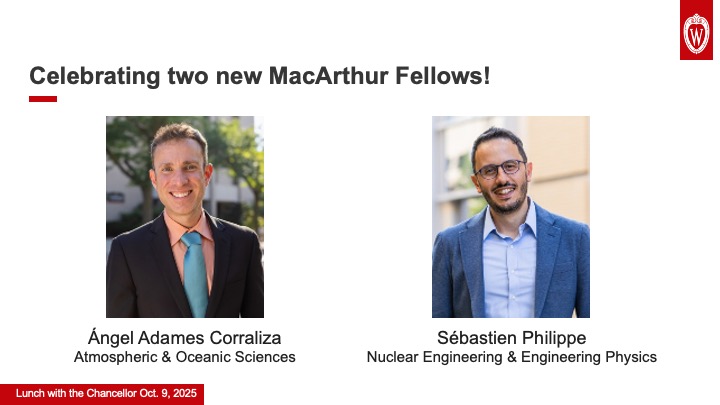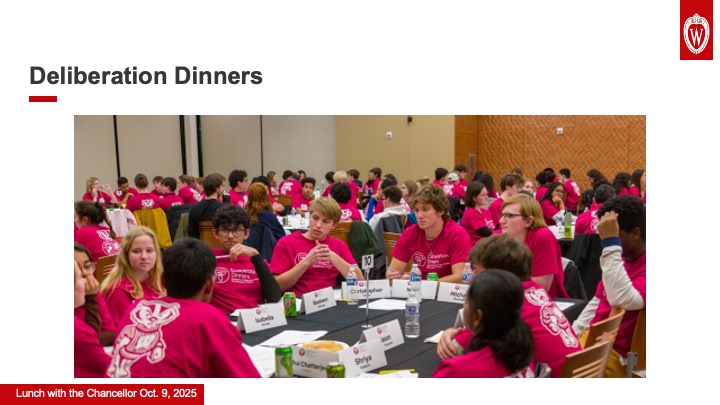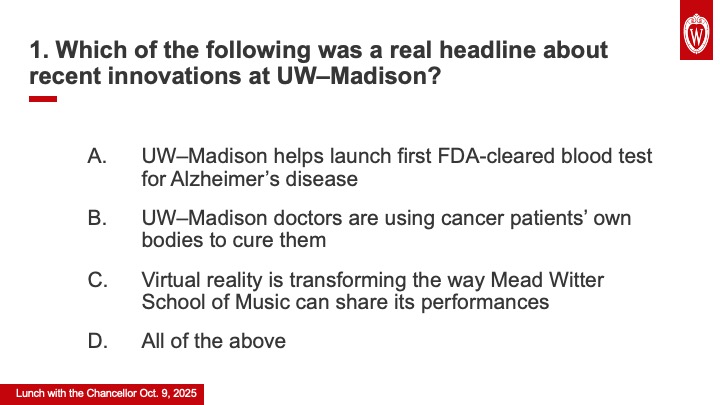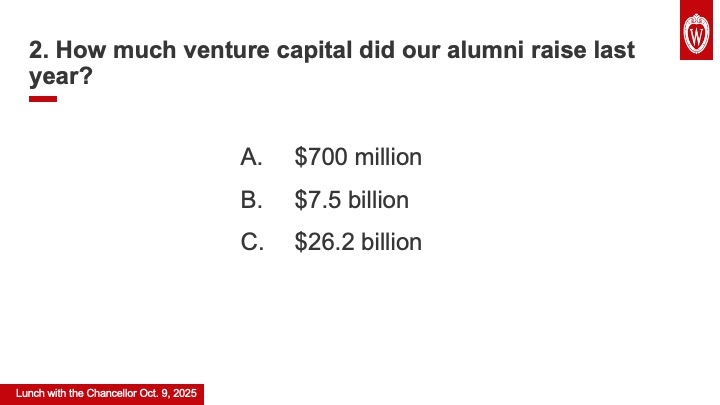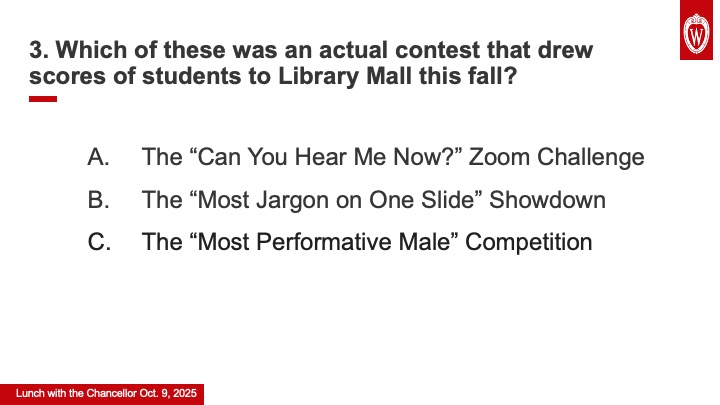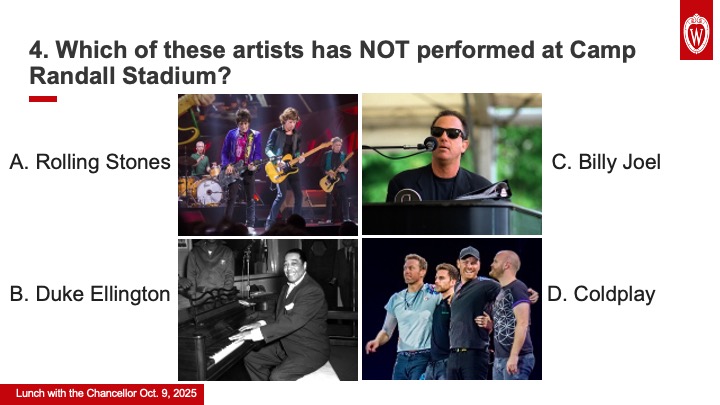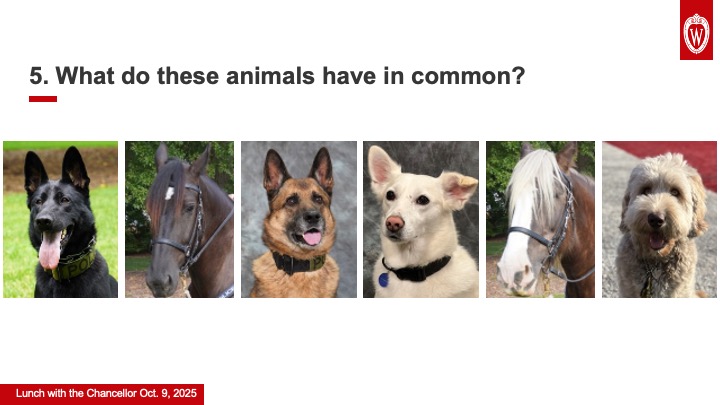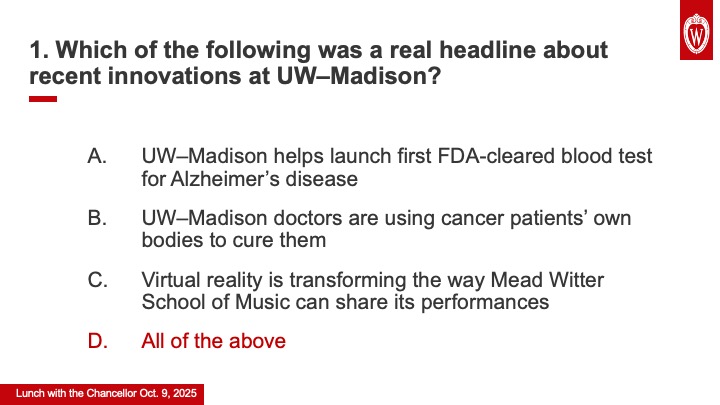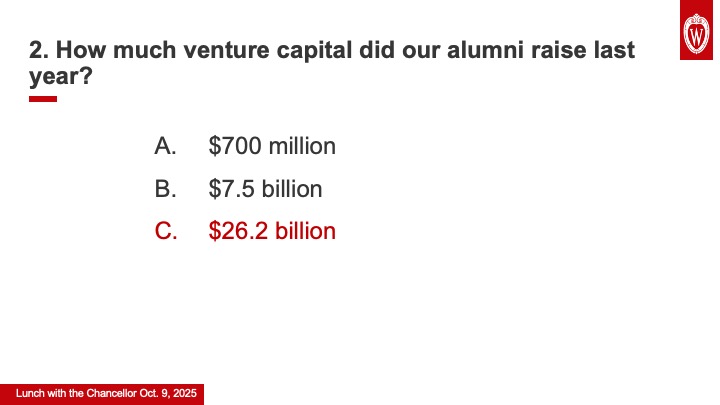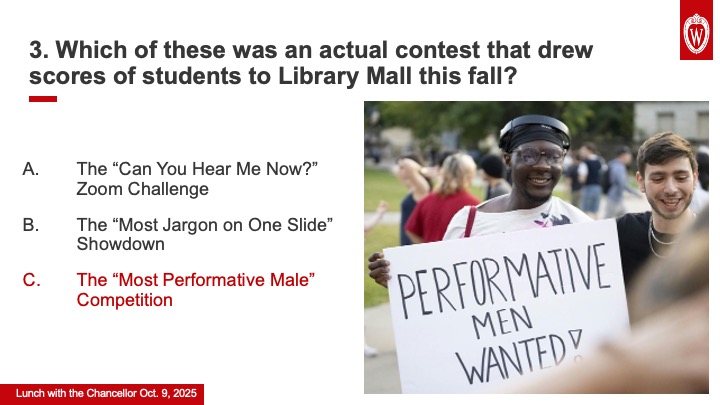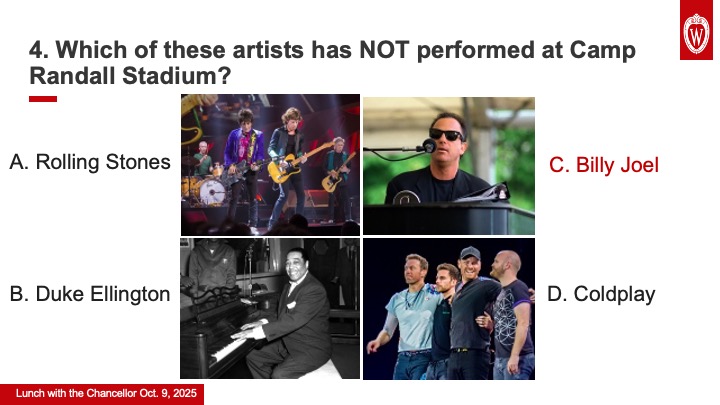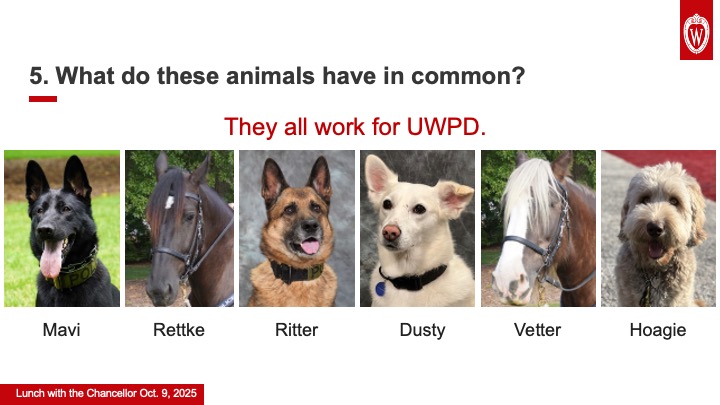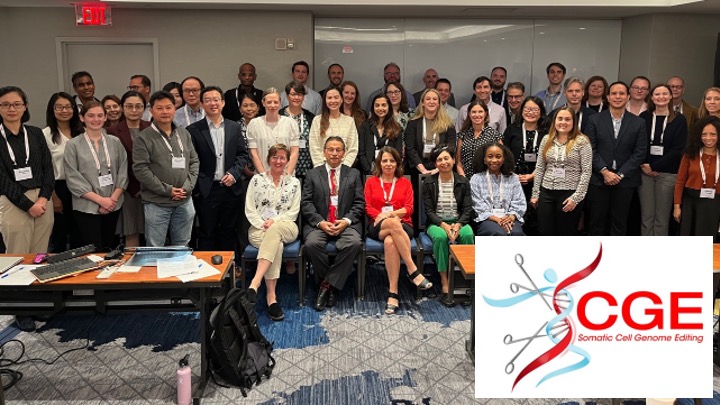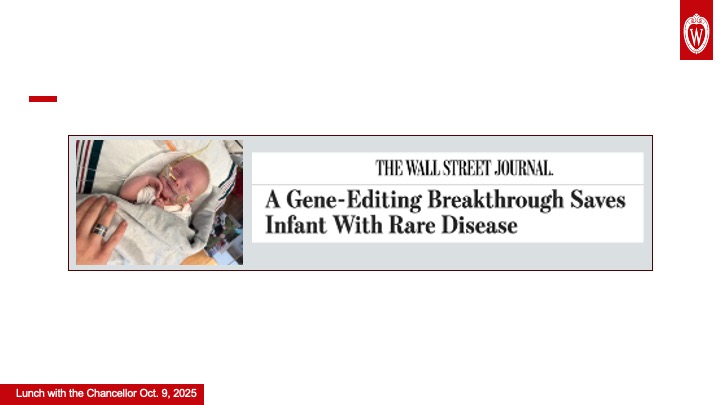Summary
Chancellor Mnookin's remarks at the 2025 Lunch with the Chancellor event.
University of Wisconsin–Madison
October 9, 2025
Thank you, Alisa and good afternoon, everyone! It’s wonderful to see you all here.
I want to say a special hello to a few student leaders with us today representing some of our most active campus organizations. They’re members of Vice Chancellor Lori Reesor’s student cabinet. Thank you for being here!
And thanks to all of you. In a year of significant change and challenge, your leadership and trusted advice have been essential — let’s give you a round of applause — thank you!
Welcome new leaders
Following tradition, I want to introduce new campus leaders (and “old” leaders in new roles):
John Zumbrunnen is our interim provost, succeeding Charles Isbell. John has been a senior vice provost overseeing teaching and learning, and he was one central architect of the RISE program that’s expanding our faculty in some exciting new directions. We’re launching a national search for a permanent replacement in fall.
We also have two new deans: Nita Ahuja, dean of the School of Medicine & Public Health and vice chancellor for medical affairs, succeeding Bob Golden, and Devesh Ranjan, dean of the College of Engineering, succeeding Ian Robertson.
I’ll ask these new leaders and our other vice chancellors, deans and directors to please stand or give a wave so we may recognize you for your service. Thank you!
We’ve brought in four new deans and two new vice chancellors in the past year-and-a-half. If you could see the incredible leaders and scholars who want to be here, you would be reminded — as I am — of the power of our national reputation as a place that’s making a real difference in the world. In every one of these searches, our top candidate has joined us here.
How we continue to do that in a moment of great disruption is what I want to address today. But let me begin with a story.
A university familiar with challenge
Two weeks ago, right here in this room, I had the privilege of hosting a conversation with Chancellor Emerita Donna Shalala, who at 84 is just as engaged and energetic as she’s been throughout her storied career.
To prepare for the conversation, I took a look through some of her papers and found a speech she gave this very same week in October, 1991. She said:
This has been a trying year for American higher education. Issues of political correctness … indirect cost rates … and budget constraints have threatened our future [and] the very nature and certainly the respect American higher education has enjoyed since its beginnings.
[And] recent changes in the political climate and public attitudes toward higher education bring us to a critical juncture in [the university’s] history.
Thirty-four years ago. Typewritten on onionskin before social media, before AI, and before many of the emerging issues that eat up so much of our time today.
I share this because I sometimes hear from people who envision a past that was free from serious challenge and hardship — but the reality is, that past never fully existed.
The story of this university is, and always has been, one of overcoming immense odds.
In fact, after the lofty pronouncements at our creation 177 years ago, we went into such deep debt to build our first buildings that university leaders had to sell off chunks of the campus for pennies on the dollar — and later buy them back for a princely sum (I see our real estate folks cringing). And in a true sign of desperation, they even borrowed money from the faculty to stay afloat!
We did not collapse under the weight of that moment, and we are not going to collapse under the weight of this one. We will meet the challenges before us with the same creativity, determination, and excellence that have allowed us to build one of the greatest institutions of higher learning in the world!
Today’s challenges are on a different scale than they were 177 years ago, or even 34 years ago, but we know their general shape.
We know how to seize the opportunities that disruption can sweep onto our shores — opportunities to unlock fresh ideas and push ourselves to new levels of excellence.
While there may be bumps and bruises, we can and will manage the threats that disruption can bring.
Certainly this year we’re experiencing both the exhilarating upside of disruption, and the dispiriting downside.
Disruption’s upside
On the upside, the pace of innovation is absolutely staggering, and this university is leading the way — in artificial intelligence … quantum computing … renewable energies … and life-saving medical advances (including one I’ll tell you about in just a few minutes). Not to mention our top-ranked programs in a vast range of disciplines — from engineering to dance, from law to printmaking to education — that are deeply engaged in exploring the many ways AI might be deployed.
AI is one of the most fundamentally disruptive changes any of us will experience in our lifetimes. AI will have some impact on nearly everything we do — from how we treat and prevent illness to how we grow crops.
It is capable of both solving vexing problems and creating them — for example, it can spread disinformation far and wide in ways that may aggravate the divisions between us and subvert our democracy.
Here at UW–Madison, our spectacular new Morgridge Hall will be the nerve center that brings in a stunning range of specialties from all over campus — from engineers to philosophers — to work together in new ways as we ride through this ‘wild west’ moment.
If you haven’t been there, I hope you’ll go. Our new facilities don’t have to be gobsmacking … but this one is!
It’s the largest and most sustainable building on this campus, built on time, under budget, and entirely through the generosity of alumni and friends, including many of you here today — let’s give you a round of applause!
One of the most visible impacts of AI is on the workforce. It’s potentially gobbling up some of the jobs that our graduates were landing just a few years ago — the media call it the ‘job-pocalypse.’
So we will need to be intentional and creative in thinking how best to prepare our students for the careers of the future.
Because in every challenge there is also opportunity.
Fueling entrepreneurship
One place you’ll see that is in our changing approach to entrepreneurship — we’re building a novel campuswide strategy for recruiting, developing, and launching entrepreneurs who so naturally drive, and thrive on, disruptive change (and help our society to fully integrate the benefits of that change).
Here’s just one small example of an entrepreneur harnessing AI to solve a problem many of us have experienced — long lines at coffee shops. Adrian Deasy is one of our mechanical engineering graduates.
He created one of the first fully robotic coffee shops in the nation — right here in Wisconsin! It’s called Octane Coffee. You order on your phone, and scan through to pay and pick up your drink.
You can visit them in Brookfield (and if we’re lucky, here in Madison one day soon).
I want to see us become a premier university for entrepreneurship — and we’re sailing in that direction with a new Entrepreneurship Hub to be led by our first-ever associate vice chancellor for entrepreneurship. We’re conducting a national search for the right person as we speak.
This will help us row in the same direction across the university.
So we’re engaging fresh ideas for transformative teaching and research, and our faculty are finding exciting new pathways to take their work to new levels of excellence.
The amazing number of awards the faculty have won this year is one sign of that impact.
I am delighted to share with you our latest news that was announced just yesterday: Two of our brilliant faculty members have just been named MacArthur “Genius Grant” Award winners!
We are the only university in the country to have two current faculty members among the winners this year.
Over the years, UW–Madison has been exceptionally successful with this award: It is rare to have even one winner on any university campus, and this year’s winners bring us to five in just the last six years!
They are:
- Ángel Adames Corraliza in our Department of Atmospheric and Oceanic Sciences. Dr. Adames Corraliza’s work to understand the dynamics of tropical weather patterns is setting the stage for vastly improved weather forecasting that can save lives and help communities better prepare for extreme weather.
- And Sébastien Philippe in our Department of Nuclear Engineering and Engineering Physics. We brought Dr. Philippe to UW–Madison just this year. He’s an expert on nuclear security who works in collaboration with communities and policymakers to better understand the risks associated with building, testing, and storing launch-ready nuclear weapons.
This is an incredible testament to the excellence of our faculty — let’s have a round of applause for the winners!
Disruption’s downside
At the same time we celebrate our truly outstanding faculty and the opportunities disruption can bring us, we also are dealing with the uncertainty and instability that go along with rapid change.
In his bestselling book, A Walk in the Woods, the author Bill Bryson observes of hiking the Appalachian Trail:
The hardest part was coming to terms with the constant dispiriting discovery that there is always more hill.
In this moment, it can sometimes feel as if there is another hill beyond every horizon.
Whether we wish for it or not, we have the enormous challenge and the tremendous opportunity to help guide a reset in the compact that’s existed between higher education and the federal government for 80 years.
A compact that’s allowed this nation to become the world’s leader in innovation and discovery.
The federal cuts to research have already had a real and meaningful effect here. We’ve shuttered research projects … endured some layoffs … and imposed budget cuts to redirect money towards essential programs that are at risk.
I am happy to tell you that because of our fiscal restraint, we are in a fairly solid place financially. But there is more danger ahead with potential federal cuts that could have a devastating impact on our medical research on so many areas, from theranostics to Alzheimer’s, for example — and it could impact basic research, clinical trials, and so much more, as well as having ripple effects across our campus.
We’ve joined nearly two dozen other states to challenge these cuts in court — and for now, a permanent injunction is in place. But there are no guarantees as these cases work their way through the appellate courts. These are risks and I can’t minimize them.
And let me be clear: There are legitimate concerns about higher education that we ought to listen to and take seriously.
For example, I do think that we can be more transparent and accountable around:
- The return-on-investment for the degrees we confer, so that students can make informed decisions about the majors they pursue and the debt they incur. I’m proud that nearly 2/3 of our undergraduates leave us with zero student debt, but there is still more we can do to support both transparency and access at both the undergraduate and graduate level.
- And there are also, I think, legitimate potential reforms in relation to how we spend federal research dollars. We have joined with national organizations to advocate for a new approach to indirect costs (the overhead costs of conducting federal research that help us build labs and pay for the regulatory infrastructure we must operate within) that would add greater transparency and clarity.
There are also, in my view, some fair critiques about viewpoint diversity on university campuses. We all know that higher ed can be in our own bubble. Here at UW–Madison, we know from polling (as is true at other universities) that some of our students who identify as conservative hesitate to speak in class not for fear of their professors, but for fear of what their peers might think.
If we don’t more actively demonstrate engagement with a broader set of viewpoints, I don’t think we’re doing our best for students or for our important commitment to preparing our graduates to be informed, active participants in a complex and diverse democracy where they’re going to engage with people who are different from themselves in every way.
So there are places where we can, and must, improve. But let me also be clear:
I will not hesitate to defend the precious institutional values that define this university’s excellence — including academic freedom, freedom of speech, and non-discrimination.
And let me add my strong support for our international students who have been part of this university since our very first class in 1849 (yes — in 1849 we had a student from Canada!).
Our international enrollment this semester is down by about 500 students — that’s a somewhat smaller reduction than what many universities are seeing — but we don’t want a single one of our admitted students to lose the opportunity to come here.
They enrich our campus culturally and academically and bring critically important perspectives that advance our research and enliven the exchange of ideas.
Polarization
Which brings me to our work to address polarization.
We must double down on helping our students learn to disagree productively and engage respectfully with one another across their differences.
Not because we think that engaging across their differences will help them reach some magical consensus or total agreement — we don’t want to be a monoculture — but because we want our campuses to be places where people are challenged in ways that sometimes change their minds and sometimes sharpen and clarify the views that they already had.
I recently heard a story from 1967 — another time of great disruption. An ROTC student named John Henz showed up to class in uniform, girding himself for hostility. And was shocked when the protestors stepped aside and said:
“You are who we are trying to save.”
He later said: “That was the great experience for me of the University of Wisconsin–Madison. This ability to get clarity in your thoughts, to keep an open mind. This is what a university education is all about.”
This university in this purple state, and with a long tradition of passionate engagement with social and political issues, has an extraordinary opportunity to be a leader and a model for the nation for how to work across differences in ways that respect our shared humanity.
Here’s one program we started two years ago, and which some of you have heard me talk about.
It’s called Deliberation Dinners, and it brings together students from diverse viewpoints with trained faculty facilitators to share meals throughout the academic year and discuss deeply polarizing issues like gun rights and immigration.
The results have been remarkable. Here’s a quote from a student who participated last year:
I often view the “progressive left” as moral grandstanders not worthy of respect, but after having conversations with many of them I learned that they are people, like me, with good intentions and I hope they realize that in me, too.
We hear similar sentiments from students who come from all places on the political spectrum.
We’ve been able to triple the number of students in this program in just two years and still can’t accommodate all of the interest — and that’s one reason why I am going to announce publicly, in the next two weeks, some campuswide opportunities and new programs that will bring our work on civil dialogue to a whole new level.
I decided on the name just last week with input from a group our students — can’t say more just yet but watch for an announcement in the coming weeks!
There are those who believe that learning to engage peacefully and thoughtfully with people whose life experiences and viewpoints differ from our own is optional.
I disagree. I say this work foundational to what we need for our students, our institutions, and our democracy, and I am excited that we’re going to do more in this space.
* * * *
Now shifting directions: For some of you, this may be the moment you were waiting for … it’s time for the quiz!
Please locate the pencils and paper on your tables. Ready?
Quiz Answers
Here are the answers. Let’s see how you did:
Our alumni raised $26.2 billion in venture capital (raised by 943 alumni; source: Pitchbook)— making us the fifth-best public university in the nation for number of graduates founding companies backed by venture capital. We’re also the second-place all-time leader in alumni joining the Peace Corps — it’s a very “UW–Madison” thing to achieve excellence across incredibly diverse measures!
This is an online trend that’s swept campuses across the country and pokes gentle fun at men who change their hobbies or style in hopes of impressing women. Contestants carry tote bags and lattes, play Fleetwood Mac songs on the guitar, and carry books by feminist authors. This is the winner, freshman Posse scholar from Chicago Khabbab Gassikia.
Billy Joel has never played at Camp Randall, but he’s appeared on campus three times: at the Stock Pavilion in the late ’70s as his career was taking off, and twice sharing the Kohl Center stage with Elton John.
These animals all work for UWPD. Horses Rettke and Vetter (named after volleyball player Dana Rettke and women’s hockey player Jessie Vetter) work crowd control; Ritter and Mavi are trained in human tracking and explosive detection; and Dusty and Hoagie are therapy dogs.
Good job! Let’s give you a round of applause!
Research breakthrough
You are clearly familiar with the amazing research happening here — but I do want to share one story about a recent major breakthrough in biomedical engineering that you likely haven’t heard about — one that shows how we can build urgently needed common ground for life-saving science.
This is a national consortium of scientists, industry leaders, ethicists, and advocates — developed and led in its inaugural years by Professor Kris Saha at the Wisconsin Institute for Discovery — which set out to answer one urgent question:
Can a new, personalized drug be developed quickly enough to save a life?
Kris and his consortium knew that a new CRISPR drug could correct genetic mutations with great precision, but they were always racing against the clock. (CRISPR is a technology that makes it possible to edit DNA; the logo you see is the NIH program that’s aiming to accelerate the transfer of these technologies out of the lab and into the world.)
They were told this would be a losing battle: Getting a new drug through the FDA could take decades.
They were told no pharmaceutical company would invest in producing a CRISPR drug for exceptionally rare diseases.
But as Kris put it: We decided that was outdated thinking.
So they worked together with the FDA to prove safety, and they worked with industry partners to establish manufacturing platforms for personalized therapies.
This year, Kris’s colleagues in Philadelphia — part of the larger consortium — used the platform to manufacture a personalized drug, and you see the result.
It took not three decades or even three years, but three months. Today, we have a new blueprint for bringing custom therapies to millions of people with rare diseases.
Even our somewhat controversial secretary of Health and Human Services, RFK Jr., heralded this result, reached out to the infant’s family, and then posted a national address about the importance of investing in cutting-edge cures for disease.
The next step will be manufacturing these therapies for rare vision disorders — in Kris’s program right here in Wisconsin, changing lives and creating new jobs along the way.
I want to thank Dr. Kris Saha, who is here today, for leading the larger national consortium and the program here on campus — will you please stand? Thank you, Kris!
Conclusion
The determination — some might call it stubbornness — to do things we’re sometimes told can’t be done has been so naturally “UW” from our earliest days. It will serve us well as we navigate the choppy waters ahead.
Which brings me back to Donna Shalala and that 34-year-old speech. An awful lot of what she said is spot-on today. But there’s one thing she didn’t get right.
She predicted that the university would grow its excellence. And we have certainly done that. But she also predicted we would shrink the student population, which we haven’t.
In fact, this year’s freshman class is one of the largest in our history, selected from a record 74,000 applicants — a double-digit increase over last year! And it includes the greatest number of first-generation students in our history.
But I understand why Chancellor Shalala couldn’t envision that we’d be able to grow in size as one of the greatest universities in the nation while simultaneously serving thousands more students, with drastically fewer state dollars.
Who could imagine that we would set new records for:
- Student retention, now at 96%, 12 points above the national average?
- Six-year graduation rate, closing in on 90%, which puts us in the top 10 public universities in the country?
- And time-to-degree — now at a record low of 3.86 years?
And who would dare to hope that we would be graduating more than 2/3 of our undergraduates with no student debt?
So I am optimistic. Not recklessly so — I am well aware of the enormity of the challenges before us.
But I deeply believe that, together, we can rise to those challenges.
I believe we can preserve and protect our values while moving beyond the structures and mindsets of the last century that may not be serving us as well.
And I believe that even in moments that feel incredibly unsettled, we can build our excellence in exciting new ways to meet our proud Wisconsin Idea mission.
Because I have seen this university do extraordinary things.
We won’t meet every challenge in a day, or even a year. And we won’t do it alone.
But with your help, we can find pathways through.
And while we do that, let’s also remember to celebrate, and to see, and to continue to be awed by the incredible things happening at this institution, and that you are all a part of.
Thank you and On, Wisconsin!
